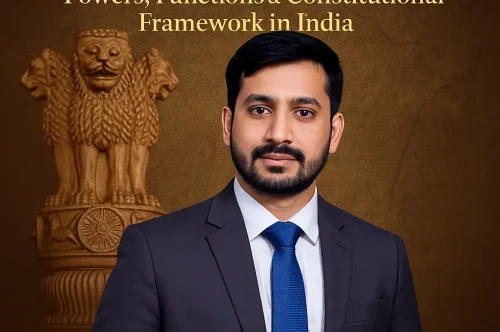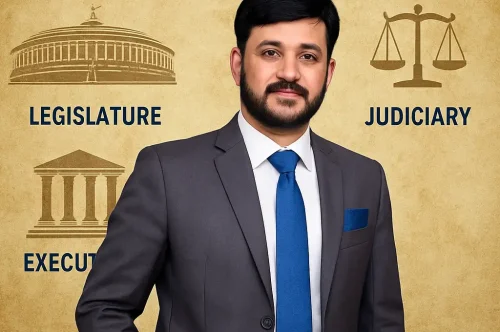Writ Jurisdiction under Articles 32 & 226 | Adv. Prakash Sharma

Writ Jurisdiction in India: Strategic Legal Remedy Under Articles 32 & 226
By Adv. Prakash Chand Sharma
Chartered Engineer | High Court Advocate | CAO
Founder – Zumosun Universe, Techlam Legal Solutions, JPSD Taxsun LLP
Powered by: TheLegalCourt.com | TheLegalBank.com
Introduction
Writ jurisdiction is one of the most powerful constitutional remedies available in India.
Articles 32 and 226 empower the Supreme Court and High Courts to enforce Fundamental Rights and ensure that public authorities act within the boundaries of law.
In practical litigation, writ petitions are filed to challenge:
-
Arbitrary government orders
-
Illegal detention
-
Administrative inaction
-
Violation of natural justice
-
Unfair recruitment and service matters
-
Property-related government actions
-
Licensing and regulatory decisions
-
Police misconduct
-
Misuse of authority by public bodies
Writ jurisdiction offers immediate, speedy, and effective relief, making it the preferred remedy for both individuals and businesses.
1. Article 32 – Supreme Court Writ Jurisdiction
Article 32 provides a direct constitutional remedy for violation of Fundamental Rights.
Scope of Article 32:
-
Can be invoked only when a Fundamental Right is violated
-
Petition filed directly before the Supreme Court of India
-
Considered the “heart and soul” of the Constitution
-
Ensures immediate protection against State excess
Cases Where Article 32 Is Commonly Used:
-
Unlawful detention
-
Freedom of speech violations
-
Internet shutdowns
-
Discrimination by State authorities
-
Police abuse of power
-
Property demolition without due process
-
Environmental violations affecting fundamental rights
Limitations:
-
Cannot be used for ordinary administrative or service matters
-
Only for enforcement of Fundamental Rights
-
Not for contractual or private disputes
2. Article 226 – High Court Writ Jurisdiction
Article 226 is wider than Article 32.
High Courts can issue writs for:
-
Violation of Fundamental Rights
-
Violation of any legal right
-
Administrative injustice
-
Malafide action by public authorities
This makes Article 226 the most used remedy in Indian constitutional litigation.
Scope of Article 226 Includes:
-
Tender disputes
-
Licensing cancellations
-
University/education matters
-
Property and land matters
-
Municipal corporation disputes
-
Police inaction
-
Revenue matters
-
Electricity board disputes
-
Regulatory authority matters (RERA, SEBI, GST, Telecom, etc.)
-
Service matters involving public employment
Why Businesses Prefer Article 226:
-
Faster than civil suits
-
Wider remedial power
-
Can challenge government contracts and tenders
-
Ideal for compliance disputes
-
Effective against arbitrary regulatory actions
3. Types of Writs Under Articles 32 & 226
1. Habeas Corpus
“Produce the body”
Used against unlawful detention or wrongful custody.
Common Uses:
-
Illegal arrest
-
Police withholding a person without FIR
-
Child custody disputes
-
Preventive detention misuse
2. Mandamus
Orders a public authority to perform a legal duty.
Used when:
-
Government delays service benefits
-
Authority refuses to issue license/certificate
-
Municipal or revenue departments do not act
-
Public officers fail in statutory duties
3. Prohibition
Issued by High Courts/Supreme Court to stop lower courts or tribunals from exceeding jurisdiction.
Used in:
-
Administrative tribunals acting beyond power
-
Wrongful assumption of jurisdiction
4. Certiorari
Used to quash orders of lower courts/tribunals.
Applied in:
-
Erroneous administrative decisions
-
Orders passed without hearing parties
-
Violation of natural justice
-
Jurisdictional errors
5. Quo Warranto
Challenges the legality of a person holding public office.
Used for:
-
Illegal appointments
-
Office held without qualifications
-
Public posts occupied improperly
4. Writ Jurisdiction vs. Civil Suits
| Feature | Writ Petition | Civil Suit |
|---|---|---|
| Speed | Very fast | Slow; takes years |
| Focus | Public law, administrative actions | Private disputes |
| Relief | Constitutional | Damages, rights enforcement |
| Evidence | Affidavits | Documentary + oral evidence |
| Authority | High Court/Supreme Court | District/High Court |
For urgent and immediate relief, writ petitions are preferred.
5. Practical Litigation Examples
Example 1: Illegal Demolition of Property
If a municipal authority demolishes property without notice—
➡ File Article 226 writ for violation of natural justice + Article 21 (right to life).
Example 2: Unfair Government Tender
If a department rejects a tender without valid reason—
➡ File Writ of Mandamus for arbitrary action.
Example 3: Police Refusing to Register FIR
➡ File Mandamus directing police to perform statutory duty under CrPC.
Example 4: Illegal Arrest
➡ File Habeas Corpus for immediate release.
Example 5: Unauthorized Occupation of Public Office
➡ File Quo Warranto to remove the person.
6. Limitations of Writ Jurisdiction
Writs cannot be filed for:
-
Private contractual disputes
-
Landlord–tenant issues (private)
-
Matrimonial disputes
-
Cases requiring detailed evidence
-
Commercial disputes between private parties
In such cases, civil suits or arbitration is appropriate.
Conclusion
Writ jurisdiction is the strongest and most efficient constitutional remedy in India. Articles 32 and 226 ensure that no authority—government or public body—acts beyond its legal power. For individuals, corporates, institutions, and businesses, writ petitions offer quick, strategic relief against illegal, unreasonable, or arbitrary actions of the State.
Understanding writ jurisdiction is essential for modern legal practice, governance, and rights protection.
Author
Adv. Prakash Chand Sharma
Chartered Engineer | High Court Advocate | CAO
Founder – Zumosun Legal, Techlam Legal Solutions, JPSD Taxsun LLP
Powered by: TheLegalCourt.com | TheLegalBank.com
Prakash Chand Sharma, the founder of Zumosun Universe and the creator of Activation Science — a transformative framework designed to activate the infinite universe within every individual, organization, and civilization.
My work focuses on unlocking PURE Intelligence and Exponential Growth, guiding humanity from potential to activation — from limitation to expansion. Through Activation, I aim to build an Activated Universe and Civilization, where every entity continuously evolves, innovates, and contributes to universal growth forever.
Follow On:-
1. https://www.linkedin.com/in/eng-adv-cao-prakash-chand-sharma-26586143/
2. https://www.facebook.com/er.adv.ca.prakash.chandsharma.35






